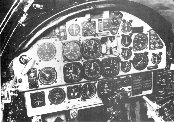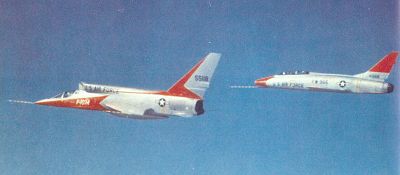North American
NA-211 F-100B
NA-212 F-100B(I)
YF-100B / YF-107A, F-107A

First prototype YF-107A 55-5118.
North AmericanNA-211 F-100B NA-212 F-100B(I) YF-100B / YF-107A, F-107A |
 First prototype YF-107A 55-5118. |
While the F-100A Super Sabre fighter-bomber was being developed, North American was also planning an advanced, high-performance multi-role follow-on, tentatively known as the F-100B. This was based on the F-100A, with a Pratt & Whitney J75 turbojet and revised nose and intake to accomodate radar. The U. S. Air Force decided to order three prototypes, which were designated YF-107A.


The F-107 had several advanced features. A fuel tank or nuclear weapon could be mounted semi-conformally on the centerline. Instead of a conventional tail and rudder, the F-107 had a one-piece, all-moving tail; this concept was proved operationally on the later North American A3J (A-5) Vigilante naval attack aircraft. The horizontal tail was all-moving as well. Spoilers mounted above and below the wings took the place of conventional ailerons. The F-107 had an area-ruled fuselage and an unusual dorsal air intake. Armament consisted of four 20 mm cannon in the nose, although it was planned to install a single M61 rotary cannon in production aircraft. In addition to the centerline station, there were four wing stations for various air-to-ground or air-to-air weapons or fuel tanks. All-weather radar and MA-12 fire-control system were planned as well.

Unfortunately for North American, there were several other projects simultaneously in various stages of development. The McDonnell F-101 strategic fighter/fighter- bomber/interceptor, Convair F-102 interceptor and Lockheed F-104 fighter were in production. The Republic F-105 fighter-bomber and Convair F-106 interceptor were being considered for production as well.

In December 1954, the USAF released GOR 68 (General Operational Requirement), which called for an aircraft to fulfill the air superiority and fighter-bomber roles in day, night or bad weather operating environments. Unfortunately for North American, the F-105 was well into development for the fighter-bomber mission, and the F-106 was being planned as a replacement for the interim F-102. The F-105 out-duelled the F-107 in a paper competition, and since there were already so many aircraft being procured, the F-107 was cancelled. It did embody enough advanced features that further testing was considered worthwhile. Test pilots from North American and the USAF continued to fly the three prototypes, until two were handed over to NASA for further testing and research. The third was delivered to the USAF Museum at Wright-Patterson AFB in Dayton, Ohio. As it was, the F-107 was the last fighter built by North American, as the later F-108 Rapier never proceeded past the mock-up stage.

Cockpit of YF-107A 55-5119.
Timeline

| Specifications | NA-211 F-100B | NA-212 F-100B(I) | YF-107A | F-107A |
| Designer(s) | ? | ? | ? | ? |
| Mission Type | Multi-role fighter | -- | All-weather fighter-bomber and interceptor prototype; later used for high-speed flight-test research | All-weather fighter-bomber and interceptor |
| Powerplant | ? | ? | 1 x 17,200 lb (7,800 kg) s.t. Pratt & Whitney YJ75-P-9 (JT4) turbojet, 24,500 lb (11,113 kg) reheated s.t. | ? |
| Dimensions | ||||
| Span | 36 ft 7 in (11.15 m) | 36 ft 7 in (11.15 m) | 36 ft 7 in (11.15 m) | 36 ft 7 in (11.15 m) |
| Length | 51 ft 8 in (15.75 m) | 52 ft 4.5 in (15.97 m) | incl. probe: 61 ft 10 in (18.84 m) excl. probe: 60 ft 10 in (18.54 in) |
60 ft 9.75 in (18.53 m) |
| Height | 14 ft 4.5 in (4.39 m) | 14 ft 1 in (4.30 m) | 19 ft 6 in - 19 ft 8 in (5.94 - 5.99 m) | 19 ft 6.5 in (5.96 m) |
| Wing area | ? | ? | 376.02 sq ft (34.93 m2) | ? |
| Weights | ||||
| Empty | ? | ? | 22,696 lb (10,295 kg) | ? |
| Combat | ? | ? | 30,272 lb (13,731 kg) | ? |
| Loaded | ? | ? | 39,755 lb (18,033 kg) | ? |
| Gross | ? | ? | 39,800 lb (18,053 kg) | ? |
| Max | ? | ? | 41,537 lb (18,841 kg) | ? |
| Performance | ||||
| Max speed | ? | ? |
890 mph @ sl (1,432 km/hr) (Mach 1.168) 1,300 mph @ 20,000 ft (2,092.1 km/hr @ 6,096 m) (Mach 2.0) 1,295 mph @ 36,000 ft (1,295 km/hr @ 10,705 m) (Mach 1.959) |
? |
| Cruise speed | ? | ? | 600 mph (966 km/hr) | ? |
| Initial climb rate | ? | ? | 31,000 ft/min (157 m/s) (clean) | ? |
| Time to altitude | ? | ? | ? | ? |
| Service ceiling | 65,600 ft (20,000 m) | 65,615 ft (20,000 m) | 53,200 ft (16,215 m) | ? |
| Range | ? | ? | 788 miles (1,268 km) | ? |
| Max range | ? | ? | 2,428 miles (3,907 km) | ? |
| Armament | ? | ? |
4 x 20 mm M-39E cannon in forward fuselage Four wing and one fuselage centerline hardpoints for mounting various air-to-air or air-to-ground weapons, including conventional or nuclear weapons |
1 x 20 mm M61A-1 rotary cannon Four wing and one fuselage centerline hardpoints for mounting various air-to-air or air-to-ground weapons, including conventional or nuclear weapons |
| Crew | One | One | One | One |
| User | USA (USAF: not operational) | USA (USAF: not operational) | USA (USAF, NACA/NASA: not operational) | USA (USAF: not operational) |
| Number built | None | None | Three (nine planned) | None |
| Construction Numbers | -- | -- | 212-1, 212-2, 212-3 | -- |
| Serial Numbers | -- | -- | 55-5118, 55-5119, 55-51120 (55-5121 through 55-5126 assigned but unbuilt) | -- |
| Unofficial nickname | -- | -- | "Super Super Sabre," "Ultra Sabre," "Man-Eater" | -- |
| Test pilots | -- | -- |
J. Robert Baker, North American chief engineering test pilot (first flight, 55-5118) J. O. Roberts, North American (first flight, 55-5119) Alvin S. White, North American (first flight, 55-5120) |
-- |
Additional Information
Web Links
| [ | Home | | | About | | | Contact | | | Top | ] |
© 1997-2011, Robert Beechy
http://www.hud607.fire.prohosting.com/uncommon/aircraft/f-107/index.html
Originally posted 1 January 2000
Modified: 07/08/2013